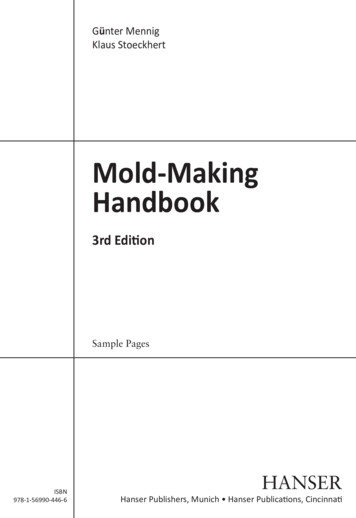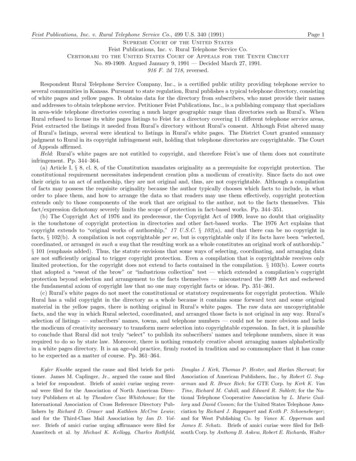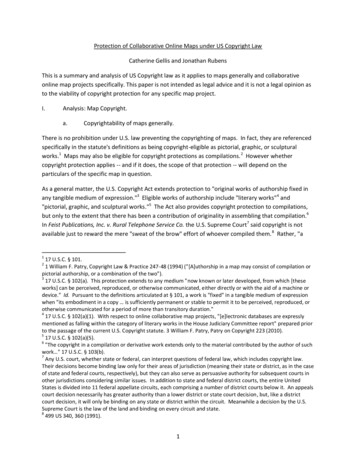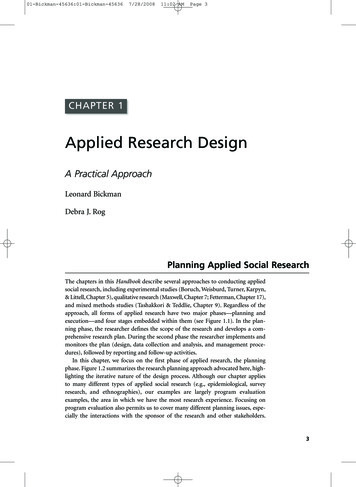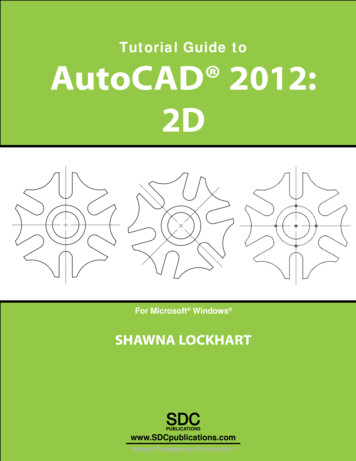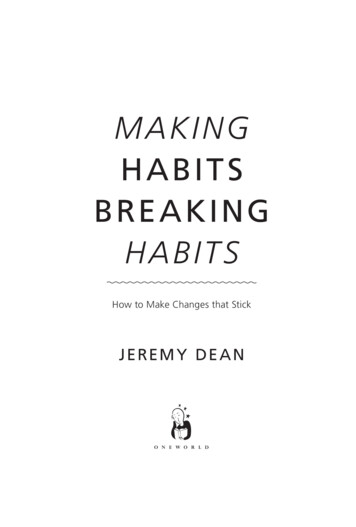
Transcription
m ak i ngh a bi t sbre a k in gha b i t sHow to Make Changes that StickJ erem y De a n
SLA o n e wor l d b o okPublished in Great Britain and the Commonwealth by Oneworld Publications 2013First published in the United States by Da Capo Press,a member of the Perseus Books GroupCopyright Jeremy Dean 2013The moral right of Jeremy Dean to be identified as the Author of this workhas been asserted by him in accordance withthe Copyright, Designs and Patents Act 1988All rights reservedCopyright under Berne ConventionA CIP record for this title is available fromthe British LibraryISBN 978-1-85168-989-7eISBN 978-1-78074-217-5Cover design by Richard GreenTypeset by Littler AscendingPrinted and bound by Norhaven A/S, DenmarkOneworld Publications10 Bloomsbury Street, London WC1B 3SR, England
To Howard and Patricia
SLFor in truth habit is a violent and treacherousschoolmistress. She establishes in us, little by little,stealthily, the foothold of her authority; but having by this mild and humble beginning settled andplanted it with the help of time, she soon uncoversto us a furious and tyrannical face against whichwe no longer have the liberty of even raising oureyes.Montaigne
Co n t en t sPa r t 1: A n ato m y o f a H a b i t1. Birth of a habit32. Habit versus intention: an unfair fight153. Your secret autopilot274. Don’t think, just do41Pa r t 2: E V ERY DAY H ABIT S5. The daily grind576. Stuck in a depressing loop83
SL7. When bad habits kill1038. Online all the time119Pa r t 3: H ABIT CH AN G E9. Making habits13910. Breaking habits15911. Healthy habits17912. Creative habits19913. Happy habits221 now read on at PsyBlog239Acknowledgements241Notes243Index265
m ak i n g h a bi t s ,bre a k i n g h a b i t s
SLIntentional Blank
Pa r t IA n ato m y o f a H a b i t
SLIntentional Blank
1Bi r t h o f a h a b i tThis book started with an apparently simple questionthat seemed to have a simple answer: How long does ittake to form a new habit? Say you want to go to the gymregularly, eat more veg, learn a new language, make newfriends, practise a musical instrument, or achieve anythingthat requires regular application of effort over time. Howlong should it take before it becomes a part of your routinerather than something you have to force yourself to do?I looked for an answer the same way most people donowadays: I asked Google. The search suggested the answerwas clear-cut. Most top results made reference to a magicfigure of 21 days. These websites maintained that ‘research’(and the scare-quotes are fully justified) had found that if311
SLMAKING HABITS, BREAKING HABITSyou repeated a behaviour every day for 21 days, then youwould have established a brand-new habit. There wasn’tmuch discussion of what type of behaviour it was, or thecircumstances you had to repeat it in, just this figure of 21days. Exercise, smoking, writing a diary, or turning cartwheels; you name it, 21 days is the answer. In addition,many authors recommend that it’s crucial to maintain achain of 21 days without breaking it. But where does thisnumber come from? Since I’m a psychologist with researchtraining, I’m used to seeing references that would support abold statement like this. There were none.My search turned to the library. There, I discovered avariety of stories going around about the source of the number. Easily my favourite concerns a plastic surgeon, Maxwell Maltz MD. Dr Maltz published a book in 1960 calledPsycho-Cybernetics in which he noted that amputees took,on average, 21 days to adjust to the loss of a limb, and heargued that people take 21 days to adjust to any major lifechange.1 He also wrote that he saw the same pattern in thosewhose faces he had operated on. He found that it took about21 days for their self-esteem either to rise to meet theirnewly created beauty or stay at its old level.The figure of 21 days has exercised an enormous powerover self-help authors ever since. Bookshops are filled withtitles like Millionaire Habits in 21 Days, 21 Days to aThrifty Lifestyle, 21 Days to Eating Better, and finally, themost optimistic of all: 21-Day Challenge: Change AlmostAnything in 21 Days (at least it acknowledges that it mightbe a challenge!). Occasionally, the 21-day period is deemed4
Birth of a habita little too optimistic and we are given an extra week totransform ourselves. These more generous titles include The28-Day Vitality Plan and Diet Rehab: 28 Days to FinallyStop Craving the Foods that Make You Fat.Whether 21 or 28 days, it’s clear that what we eat, how wespend money, or indeed anything else we do, has little incommon with losing a leg or having plastic surgery. To takeDr Maltz’s observations of his patients and generalize themto almost all human behaviour is optimistic at best. It’s evenmore optimistic when you consider the variety amongsthabits. Driving to work, avoiding the cracks in the pavement, thinking about sport, walking the dog, eating a salad,booking a flight to China; they could all be habits, and yetthey involve such different areas of our lives. But, to be fair,Maltz didn’t invent the 21-day time frame; there are all sortsof stories explaining its origins, most of them standing onscience-free ground.Thanks to recent research, though, we now have someidea of how long common habits really take to form. In astudy carried out at University College London, 96 participants were asked to choose an everyday behaviour that theywanted to turn into a habit. 2 They all chose something theydidn’t already do that could be repeated every day. Manywere health-related: people chose things like ‘eating a pieceof fruit with lunch’ and ‘running for 15 minutes after dinner’. On each of the 84 days of the study, they logged into awebsite and reported whether or not they’d carried out thebehaviour, as well as how automatic the behaviour had felt.As we’ll soon see, acting without thinking, or ‘automaticity’,511
SLMAKING HABITS, BREAKING HABITSis a central component of a habit.So, here’s the big question: how long did it take to forma habit? The simple answer is that, on average, across theparticipants who provided enough data, it took 66 daysuntil a habit was formed. And, contrary to what’s commonly believed, missing a day or two didn’t much affecthabit formation. The complicated answer is more interesting, though (otherwise this would be a short book). As youmight imagine, there was considerable variation in how longhabits took to form depending on what people tried to do.People who resolved to drink a glass of water after breakfastwere up to maximum automaticity after about 20 days,while those trying to eat a piece of fruit with lunch took atleast twice as long to turn it into a habit. The exercise habitproved most tricky with ‘50 sit-ups after morning coffee’,still not a habit after 84 days for one participant. ‘Walkingfor 10 minutes after breakfast’, though, was turned into ahabit after 50 days for another participant.The graph shows that this study found a curved relationship between repeating a habit and automaticity. This meansthat the earlier repetitions produced the greatest gains towards establishing a habit. As time went on these gains weresmaller. It’s like trying to run up a hill that starts out steepand gradually levels off. At the start you’re making greatprogress upwards, but the closer you get to the peak, thesmaller the gains in altitude with each step. For a minorityof participants, though, the new habits did not come naturally. Indeed, overall the researchers were surprised by howslowly habits seemed to form. Although the study only cov6
Birth of a habitOn average, habit formation took 66 days. Drinking aglass of water reached maximum automaticity after 20days; for 50 sit-ups, it took longer than the 84 days of thestudy.ered 84 days, by extrapolating the curves it turned out thatsome of the habits could have taken around 254 days to form– the better part of a year!What this research suggests is that taking 21 days to forma habit is probably right, as long as all you want to do is drinka glass of water after breakfast. Anything harder is likely totake longer to become a quite strong habit, and, in the case ofsome activities, much longer. Dr Maltz and his cheerleadersweren’t even close, and all those books promising habitchange in only a few weeks are grossly optimistic. Ofcourse, this study opens up a whole new set of questions.The participants were only trying to adopt new habits; what711
SLMAKING HABITS, BREAKING HABITSabout our existing habits? How much better might theyhave done using tried-and-tested psychological techniques?And this study doesn’t really tell us what a habit feels like,how we experience it, or where it tends to happen.What do we actually do all day long? Some busy days slipby in a flash and we remember little. Whether at work oridling around at home, it would be fascinating to know exactly how our time is spent and which parts of it are habitual. Unfortunately, there’s a very good reason why we tendto be awful at recalling habitual behaviour, which is to dowith its automaticity. So psychologists use diary studies,which give a much more accurate picture of what people areup to than we can get from memory. In one study led byhabit researcher Wendy Wood, 70 undergraduates at TexasA&M University were given a watch alarm.3 Every hourwhile they were awake, it reminded them to write downwhat they were doing, thinking, and feeling, right at thatvery moment. The idea was not just to build up a list of activities, but to see the context in which they occurred.Across two separate studies, the researchers found thatsomewhere between one-third and half the time people wereengaged in behaviours which were rated as habitual. Thissuggests that as much as half the time we’re awake, we’reperforming a habit of one kind or another. Even this highfigure may well be underestimated, since it’s based only onyoung people whose habits haven’t had much of a chance tobecome ingrained.48
Birth of a habitSo, what were participants in Wood’s research up to?Since they were students, the largest category was studying.This included attending lessons, reading, and going to thelibrary, which made up 32% of the diary entries. Amongstthese activities, about one-third were classified as habitual.The next category was entertainment, which participantswere engaged in for 14% of the time. This included thingslike watching TV, using the Internet, and listening to music.This time, the percentage of habitual activities went up to54%. Next on the list were social interactions, which madeup 10% of the entries and 47% of which were classified ashabitual behaviours. The category in which the behaviourswere least habitual was cleaning, down at only 21%, whilethe category which was most habitual was going to sleepand waking up at 81% (at least they weren’t hiding theirlazy, slovenly ways!).More important than precisely what they were doing (especially for those of us who aren’t students), are the characteristics of habits. What does it feel like? What’s going on inour minds? What emerged from this study, as it has fromothers, are three main characteristics of a habit. The first isthat we’re only vaguely aware of performing them, likewhen you drive to work and don’t notice the traffic lights.You know that some part of your mind was attending tothem, along with other road-users and the speed limit, butoften you can’t specifically remember doing so. In Wood’sstudy, participants reported exactly this vagueness abouttheir habitual behaviour. While they were relaxing, watching TV, or brushing their teeth, they reported thinking911
SLMAKING HABITS, BREAKING HABITSabout what they were doing only 40% of the time. It’s oneof the major benefits of a habit: it allows us to zone out andthink about something else, like planning a weekend trip.Habits allow the conscious part of our minds to go a-wandering while our unconscious gets on with those tediousrepetitious behaviours. Habits help protect us from ‘decision fatigue’: the fact that the mere act of making decisionsdepletes our mental energy. Whatever can be done automatically frees up our processing power for other thoughts.A habit doesn’t just fly under the radar cognitively; it alsodoes so emotionally. And this is the second characteristicthat emerged: the act of performing a habit is curiouslyemotionless. The reason is that habits, through their repetition, lose their emotional flavour. Like anything in life, aswe become habituated our emotional response lessens. Theemotion researcher Nico Frijda classifies this as one of thelaws of emotion, and it applies to both pleasure and pain.5Activities we once considered painful, like getting up earlyto go to work, become less so with repetition. On the otherhand, activities which excite or give us pleasure initially, likesex, beer, or listening to Beethoven’s Seventh, soon becomemundane. Of course, we fight against the leaking away ofpleasure, sometimes with success, by seeking variety. Thisis why some people feel they have to keep pushing theboundaries of experience just to get the same high.None of this means we don’t feel emotion while performing a habit, it’s just that the feelings we experience usuallyhave less to do with the habit and more to do with where ourminds have wandered off to. Wood’s research found this10
Birth of a habitexact pattern in participants’ reports of their emotional experience. Compared with non-habitual behaviours, whenpeople were performing habits their emotions tended not tochange. In addition, the emotions that people did experiencewere less likely to be related to what they were doing thanwhen their activities were non-habitual. The fact that habitual behaviour doesn’t stir up strong emotions is one of itsadvantages. Participants in this study felt more in controland less stressed while performing habits than they did enacting non-habitual behaviours. The moment participantsswitched to non-habitual behaviours, their stress level increased.The third important characteristic of a habit is so obvious that often we don’t notice it. Perhaps this is partly a result of the automatic nature of habits. Take some typicaldaily routines: You get up in the morning, go to the bathroom, and have a shower . . . Later you’re in the car when youturn on your favourite radio station . . . Then, at the coffeeshop, you order a blueberry muffin . . . The connection iscontext. We tend to do the same things in the same circumstances. Indeed, it’s partly this correspondence between thesituation and behaviour that causes habits to form in the firstplace.The idea that we create associations between our environment and certain behaviours was memorably demonstratedby the Russian physiologist Ivan Pavlov. In Pavlov’s mostfamous research, carried out on dogs, he created an association between being fed and the sound of a bell ringing.Then, after a while, he tried ringing the bell without feeding1111
SLMAKING HABITS, BREAKING HABITSthe dog. He noticed that the dog began to salivate anyway.The toilet, car, and coffee shop are like Pavlov’s bell, unconsciously reminding us of long-standing patterns of behaviour, which we then enact again, in exactly the same way asbefore. This is backed up by research on humans that showsthat people tend to perform the same actions in the samecontexts. In the diary study described above, most of thebehaviours, like socializing, washing, and reading, were carried out in the same place.It becomes clear just how much context is important forhabit whenever you move house or get a new job. Once in anew home, it’s suddenly difficult to do the simplest of jobs.Making a sandwich becomes an ordeal as you have to thinkconsciously about where the knives and plates are. It’s notjust simple tasks that become more difficult; it’s all yourusual routines. From getting up in the morning to going tobed at night, so many tasks feel like they’re being done forthe first time. You may even find yourself trying to carryout your old habits in your new home, to no avail: becauseeverything has moved, suddenly those ingrained ways ofbehaving fail you. The same goes for new jobs. Where onceyou glided around the workplace on autopilot from onetask to the next, in the new job you feel like a fish out ofwater.Psychologists have seen how important context is during research on how people cope with changes to their environment. In one study, students’ habits were tracked asthey transferred to a new university.6 They were asked howoften they watched TV, read the paper, and exercised both12
Birth of a habitbefore the move and afterwards. They were also asked aboutthe context in which these habitual behaviours were performed. How did they perceive the context, where werethey physically, and who was with them at the time? Theanswers to these questions built a picture of whether thecontext had really changed with the move from one locationto another. For example, it’s possible that although a physical location changes, the overall context doesn’t. Like hotelrooms, one hall of residence can look much like another; soit might not feel that things have changed much.What the participants reported as they moved from oneuniversity to another was that context was important inhabit change. They found that if they wanted to cut downtheir TV and increase their exercise, it was easier to do soafter the move. This is because new surroundings don’t haveall the familiar cues to our old habits. Without these cues,our autopilot doesn’t run so smoothly and our consciousmind keeps asking us what to do. That’s why moving houseis like going on holiday: without your established routines,you have to keep consciously thinking about what you’regoing to do now. The same thing happened to these students. Instead of automatically watching TV or reading thenewspaper, they were more likely to think, ‘What did I planto do today?’ and ‘What do I actually want to do now?’ Asa consequence, a world of possibility opens up.The rather bland word ‘context’ can also include otherpeople. Whether we notice it or not, we are heavily influenced by those around us. The researchers in this studyfound that participants’ behaviour was disrupted by any1311
MAKING HABITS, BREAKING HABITSchanges in the behaviour of those around them. For example, students reported that they changed their newspaperreading habits if those around them changed theirs. It isn’tnecessarily the case that we copy other people, just that theytend to cause some change in us. This ties in with the finding that people who live alone report more of their dailybehaviours as being habitual than those who live with others.7 Other people, then, disrupt our routines, sometimes forbetter, sometimes for worse.Now we’ve seen how habits are born, what they feel like,and how much of our daily lives they take up. Three characteristics have emerged: firstly, we perform habits automatically without much conscious deliberation. Secondly,habitual behaviours provoke little emotional response bythemselves. Thirdly, habits are strongly rooted in the situations in which they occur. We also know that they can varyconsiderably in how long they take to form. But how muchcontrol do we have over our habits? If we want to make achange, how easy will it be?SL14
2H a b i t v er su s i n t en t i o n :a n u n fa i r fi g h tWe like to think that our habits follow our intentions.If I want to form a habit, I should be able to. Say Idecide to switch from white to wholewheat bread. I buy itfrom the supermarket a few weeks in a row; I like it so Ikeep getting it. With each repetition, the habit gets a littlestronger, and after a few months I’m picking it up off theshelf without even thinking about it. I intended to eat morehealthily, and now I am. Just the same sort of process, withour intentions flowing into our habits, goes on in all sorts ofareas of life: learning to ride a bike, dance, or cook. Individual physical actions are built up over time into chains ofbehaviour we perform automatically.Mental habits can be built up in just the same way, again1511
SLmaking habits, breaking habitswith intentions flowing into habitual ways of thinking. Youmight decide you’re being too harsh on a friend, say, by always thinking they are selfish. You make a mental note tospot a more benevolent trend in their behaviour. You noticewhen they buy you a drink and listen to your problems.Small things, but steps in the right direction. Sure enough,you start to think of them as less selfish. Unconsciously, thehabitual ways in which you think about your friend havechanged.Our mental habits can change in this way because ourminds are so good at spotting patterns; indeed, it’s one ofthe mind’s chief functions. Our ability to spot patterns atlow levels and build them up into a habit, based on our conscious intentions, enables us to reach much more complexgoals. Here’s an example from a classic psychology study.Participants sat in front of a computer for almost an hour,pressing one of four buttons corresponding to where a crossappeared on the screen.1 Naturally, it was very boring, butthe designers of the experiment had a little trick up theirsleeve. Unknown to the participants, there was a pattern inwhere the crosses appeared. Despite it being consciously undetectable, the participants began to respond faster as thestudy went on – they were learning the pattern. When interviewed afterwards, though, none had noticed anything: theyhad learnt it without realizing. This is a study about unconscious learning, but it demonstrates how mental habits cangrow out of patterns. Here, an unconscious learning processwas evolving in the service of a higher-level intention: to dowell on the test and please the experiment’s designers.16
Habit versus intentionWhen you learn to serve in tennis or reverse a car into atight space, it’s the physical equivalent of this unconsciousmental learning process. Lots of small unconscious actionsare built up to achieve one big conscious goal: taking a serveor parking a car. In the mental realm, mathematics is anearly example of this building-up process. At school, welearn a series of operations we can perform on numbers toreach a goal: say, working out the average height of ourschoolfriends. Although learning these basic operations (addition and division) can be excruciating for young minds,they soon become second nature. Later on, we can performthem almost without conscious thought, which enables usto complete much more complex calculations. Once again,the habit of particular mental or physical operations helpsus achieve a whole series of higher-order goals.We all have an intuitive sense that our habits are built uppurely in the service of our goals (remember that bad habitsare also goal-oriented, although the goal may not be a goodone, like getting drunk to forget one’s problems). Indeed, thestronger people’s habits, the more they believe that thosehabits are goal-oriented. 2Our intuitive sense that intentions lead straight into habits is far from just a lay understanding. Many influentialpsychologists have expressed exactly the same idea. Generations of first-year undergraduate psychologists are taughtthat intentions are a major key to predicting behaviour.They learn theories with grand-sounding names like the‘model of interpersonal behaviour’3, the ‘theory of plannedbehaviour’4, and the ‘theory of reasoned action’5, which all1711
SLmaking habits, breaking habitssuggest that when we form an intention, it leads us to act inline with that intention. These are influential ideas acrossdifferent sub-disciplines of psychology and they underpinmuch research.Now these theories are being challenged because, likeour intuitive understanding, they don’t tell the full story.We may like to think our intentions flow directly into ourhabits, but often they don’t. It’s an idea we resist because itstrikes at our sense of having free will. We like to think thatthings happen for a reason, and that one of those reasons isbecause we decided it would happen, or at the very least,that someone else decided it would happen. Yet habits don’tflow solely from our intentions, and there are studies thatdemonstrate this.Worse for our sense of agency, it’s possible for intentionand habit to be completely reversed. Sometimes we unconsciously infer our intentions from our habits. How the habitstarted in the first place could be a complete accident, but wecan then work out our intentions from our behaviour, aslong as there’s no strong reason for that behaviour. Say Itake a walk around the park every afternoon and each timeI follow a particular route which takes me past a duck pond.When asked why I take this route, I might reply that I liketo watch people feeding the ducks. In reality, I just walkedthat way the first time, completely at random, and saw noreason not to do the same the next day. Now, after the habitis established, I try to come up with a reason, and the ducksspring to mind. I end up inferring intention from what wasessentially just chance.18
Habit versus intentionWe know people regularly do this sort of backwardsthinking, and really believe it. One of the most famous examples in psychological research is cognitive dissonance.This is the idea that people don’t like to hold two inconsistent ideas to be true at the same time. Studies conductedmore than half a century ago find that when people are induced into behaviour that is inconsistent with their beliefs,they simply change their beliefs to match.6 It’s like whensomeone ends up spending too much on a new car. Insteadof feeling bad about the clash between their original planand what they’ve actually done, they prefer to convincethemselves that the car is worth the extra money. This is aresult of our natural desire to maintain consistency betweenour thoughts and actions. We all want to be right, and onething we should all be able to be right about is ourselves.Backwards thinking allows us to do just that.But surely we would know if we were doing this kind ofbackwards thinking? Unfortunately, though, we have littleaccess to these sorts of unconscious processes. It turns outthat in experiment after experiment, psychologists canchange minds without participants realizing. In one studyon attitudes, people clearly changed their mind on an issueafter being bombarded with reasons to do so.7 Despite this,they claimed the arguments had had no effect on them; indeed, they thought their new attitudes were what they hadalways thought. It seems politicians aren’t alone in blankingout their U-turns. Like it or not, we’re all capable of it.1191
SLmaking habits, breaking habitsWhat we’ve explored so far are two extremes: when we create habits intentionally for a particular purpose, and whenwe infer intentions from our behaviour. In real life, though,both of these processes happen at the same time, and habitis a combination of our intentions and our past behaviour.So here’s the crucial question: what kind of combination?Can the intention to start eating healthily or get a new jobreally overcome the habit of eating junk food and going tothe same office every day?We already know quite a lot about this question becausepsychologists are very keen to change people’s behaviour,hopefully for the better. Studies on donating blood, exercising, recycling, and voting have all examined whether it’spossible to change people’s habits. One of these tested ifparticipants could predict their own consumption of fastfood, how much they watched TV news, and how oftenthey took the bus over a week.8 Each person was asked howmuch they intended to carry out each of those three behaviours over the coming week. Then, they were asked howoften they had performed each behaviour in the past. Theseare the measures of intention and habit. Over the next 7days, participants noted down how often they went into afast-food restaurant, watched TV news, and took the bus.The results showed that when established habits wereweak, intentions tended to predict behaviour. So, if youdon’t watch TV news that much, your intention for thecoming week, whether it’s to watch more, less, or the same,is likely to be accurate. Good news for our sense of selfcontrol. Here comes the bad news. As habits get stronger,20
Habit versus intentionour intentions predict our behaviour less and less. So, whenyou’re in the habit of visiting fast-food restaurants, for example, it doesn’t matter much whether you intend to cutdown or not, chances are that your habit will continue.It gets worse, though. Participants were also asked howconfident they were in predicting their behaviour over thecoming 7 days. An unusual result emerged. Those with thestrongest habits, who were the least successful in predictingtheir behaviour over the coming week, were the most confident in their predictions. The finding is striking because ithints at one of the dark sides of habits. When we perform anaction repeatedly, its familiarity seems to bleed back intoour judgements about that behaviour. We end up feeling wehave more control over precisely the behaviours that, in reality, we have the least control over. It’s another example ofour thought processes working in the opposite way to ourintuitive expectations.Considering how powerful habits are in the face of conscious intentions, it is vital to know what a strong habit iscompared with a weak habit. For example, is buying a pairof shoes once a month a habit? What about reading thenewspaper every day, or attending a community meetingtwice a year? How often before we find it increasingly difficult to stop ourselves or, put the other way round, no longer have to force ourselves? Psychologists have looked atthis in a review of 60 different research reports on habitualbehaviour.9 They classified habits into two categories. In the2111
SLmaking habits, breaking habitsfirst category they put
MAKING HABITS, BREAKING HABITS 4 you repeated a behaviour every day for 21 days, then you would have established a brand-new habit. There wasn’t much discussion of what type of behaviour it was, or the circumstances you had to repeat it in, just this figure of 21 d
